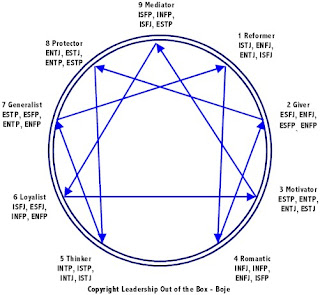 You can find game inspiration in many places. That's why it is often said that being "well-read" and having diverse interests is a boon to creativity.
You can find game inspiration in many places. That's why it is often said that being "well-read" and having diverse interests is a boon to creativity.One of those places to find inspiration is popular psychology. I must admit, I love hitting the bargain-basement bins at the bookstores, picking up pop psychology and "speculative non-fiction" books.
About a decade ago, I attended a party where about 30 of us took the Myers-Briggs test and shared the results. Having know most of those people previously, it was illuminating to discover new things about them, based on that personality test.
Years later, I took the Enneagram test. I prefer that typology to the one used in the Myers-Briggs System, as it seems more prescriptive that descriptive: the Enneagram promotes self-improvement, whereas the Myers-Briggs seems to merely pidgeonhole you.
Bringing this all back to D&D: there are many ways that players can classify their characters. The traditional approach is by character class, whether it be the Fighter, the Magic-User, or some other class. Another approach to character class could be based on Enneagram typologies. You could play the Thinker, the Loyalist, the Motivator, the Protector, and so on. Each in their own way, the classes, archetypes, typologies, or what have you, represent abstractions of reality, and different ways of seeing and interacting with the world. But just because I am a "reformer"in the enneagram typology does not mean I am the same as every other "reformer."
I don't know that I am promoting a switch to the Enneagram for D&D character creation. However, looking at role-playing from a pop psychology perspective would be interesting.
No comments:
Post a Comment